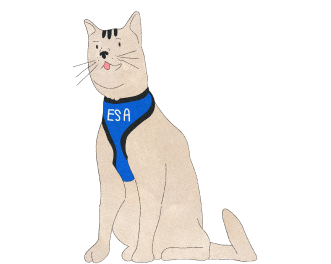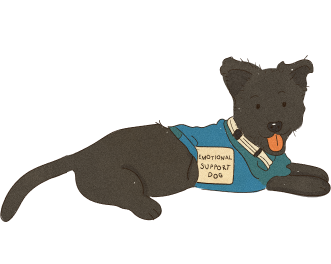Service dogs are highly trained animals that provide invaluable assistance to people with disabilities. These dogs are trained to perform a wide array of tasks including but not limited to, guiding their handlers, alerting them to incoming danger, and assisting with daily tasks such as opening doors and retrieving items.
Understanding Service Dog Vests
What is a Service Dog Vest?
A service dog vest is a piece of equipment that is designed to help identify a service dog and its handler. These vests are typically made from durable materials and are often brightly colored or adorned with patches or badges that indicate the status of the dog as a service animal.
Service dog vests are an important tool for handlers and their dogs. They help to clearly identify the dog as a working animal and can help to prevent confusion or misunderstandings in public spaces. Additionally, service dog vests can help to provide a sense of security and comfort for the handler, knowing that their dog is clearly identified and recognized as a service animal.
Different Types of Service Dog Vests
There are many different types of service dog vests available on the market. Some vests are designed to be worn year-round, while others are more weather-specific. Additionally, some vests may be more appropriate for certain types of work or activities.
One type of service dog vest is the mesh vest, which is designed to be lightweight and breathable for dogs working in warm weather. These vests are often made from a mesh material that allows air to circulate around the dog’s body, helping to keep them cool and comfortable while they work.
Another type of service dog vest is the winter vest, which is designed to keep dogs warm and dry in cold weather. These vests are often made from a waterproof material and may be insulated to help keep the dog’s body heat in.
There are also service dog vests that are designed for specific types of work or activities. For example, a search and rescue vest may have pockets or attachment points for equipment, while a therapy dog vest may have patches or badges that indicate the dog’s role as a therapy animal.
Legal Requirements and Regulations
When it comes to service animals, it’s important to understand the legal requirements and regulations that govern their use. These regulations help to protect the rights of individuals with disabilities and ensure that service animals are able to perform their duties safely and effectively.
The Americans with Disabilities Act (ADA) Guidelines
The Americans with Disabilities Act (ADA) is a federal law that was enacted in 1990 to protect the rights of individuals with disabilities. The ADA prohibits discrimination against people with disabilities and sets forth guidelines for service animals and their handlers.
Under the ADA, a service animal is defined as a dog that has been trained to perform specific tasks for an individual with a disability. These tasks may include guiding individuals who are blind, alerting individuals who are deaf, pulling a wheelchair, or providing assistance with daily tasks such as opening doors or retrieving objects.
Service animals are allowed to accompany their handlers in all areas where the public is normally allowed to go, such as restaurants, stores, and hotels. They are also allowed to accompany their handlers on public transportation, including buses, trains, and airplanes.
The ADA also sets forth regulations regarding the use of vests to identify service animals in public places. While vests are not required by law, they can be helpful in identifying a service animal and can help to prevent confrontations with business owners or other individuals who may not be familiar with the laws regarding service animals.
State and Local Laws
In addition to the federal guidelines set forth by the ADA, there are also state and local laws that govern the use of service dogs. These laws may vary depending on the state or locality, so it is important to understand the laws in your specific area to ensure that you are in compliance with all regulations.
Some states may have additional requirements for service animals, such as mandatory registration or certification. It is important to research the laws in your area to ensure that you are following all necessary regulations.
It is also important to note that while emotional support animals (ESAs) can provide comfort and support to individuals with mental health conditions, they are not considered service animals under the ADA. ESAs do not have the same legal protections as service animals and may not be allowed in all public places.
Overall, understanding the legal requirements and regulations surrounding service animals is essential for both handlers and business owners. By following these guidelines, we can ensure that individuals with disabilities are able to access the services and accommodations they need to live full and independent lives.
Benefits for Service Dogs and Their Handlers
Increased Accessibility in Public Spaces
By wearing a service dog vest, these animals are more easily identifiable in public spaces, which helps reduce the likelihood of interference from others. This increased accessibility allows handlers to take their service dogs with them on everyday tasks, which helps to promote independence.
For example, a service dog can help a visually impaired individual navigate through crowded areas, such as a busy shopping mall or a bustling city street. With the help of their service dog, the handler can feel more confident and secure in these situations, knowing that their furry companion is there to guide and protect them.
Additionally, service dogs can provide assistance to individuals with physical disabilities, such as opening doors or retrieving items that are out of reach. By allowing service dogs to accompany their handlers in public spaces, these individuals are able to live more independently and with greater ease.
Reducing Unwanted Attention and Distractions
Service dog vests help to reduce the amount of unwanted attention and distractions that service dogs may receive while out in public. By indicating to others that the dog is a service animal, people are less likely to approach and distract them while they are working.
Distractions can be particularly harmful for service dogs who are trained to perform specific tasks for their handlers, such as alerting them to the presence of allergens or providing support during a panic attack. By reducing the amount of unwanted attention and distractions, service dogs are better able to focus on their important work and provide the necessary assistance to their handlers.
Furthermore, service dogs are often used by individuals with invisible disabilities, such as PTSD or anxiety. These individuals may experience heightened anxiety or panic attacks in public spaces, and having a service dog by their side can provide a sense of comfort and security. By reducing unwanted attention and distractions, service dogs can better assist their handlers in managing their symptoms and navigating through challenging situations.
Enhancing Communication Between Dog and Handler
Wearing a service dog vest can also have a positive impact on the communication between the dog and its handler. By wearing the vest, the handler is able to signal to the dog that it is time to work and focus, which can be beneficial in a variety of situations.
For example, when a service dog is wearing its vest, the handler can signal to the dog that it is time to work and provide assistance, such as retrieving medication or guiding the handler through a busy area. This clear communication can help the dog understand its role and perform its tasks more effectively.
Additionally, service dogs often work in high-stress environments, such as hospitals or airports. By wearing a service dog vest, the dog can better understand when it is time to focus and work, and when it is time to relax and take a break. This clear communication can help service dogs better manage their stress and perform their important work with greater ease.
Properly Identifying Your Service Dog
Importance of Service Dog Identification
Proper identification of a service dog is crucial for many reasons. Service dogs are specially trained animals that work with individuals with disabilities to perform tasks that help them with their daily lives. These tasks can include anything from guiding a blind person through a busy street to alerting a person with epilepsy of an oncoming seizure. Therefore, it is essential to ensure that these dogs are allowed in public places and have access to the facilities they need to perform their duties.
Furthermore, proper identification can help prevent misunderstandings or conflicts with other individuals who may not understand the role of a service animal. For example, a person may mistake a service dog for a pet and try to pet or play with the animal, which can distract the dog from its duties and put the handler at risk. Therefore, clear identification can help prevent such situations and ensure that service dogs can perform their important tasks effectively.
Service Dog Patches and Badges
One popular method of identifying a service animal is through the use of patches and badges. These patches often have messages or symbols that indicate the dog’s role as a service animal, such as “Service Dog” or “Do Not Pet.” They can be easily attached to a vest or harness worn by the dog, making it easier for others to identify the animal as a service dog.
Some patches and badges may also include additional information, such as the handler’s contact information or a medical alert symbol indicating the handler’s disability. This information can be helpful in case of an emergency or if the dog becomes separated from its handler.
Service Dog ID Cards
In addition to patches and badges, some service animals may also carry identification cards. These cards may include information about the animal and its handler, such as the handler’s name, contact information, and the dog’s name and breed. Some cards may also include a photo of the dog for easier identification.
Service dog ID cards can be particularly useful when traveling, as they can help expedite the process of going through security checkpoints or boarding airplanes. They can also serve as a backup form of identification in case the dog’s patches or badges become lost or damaged.
It is important to note that while service dog identification can be helpful, it is not legally required in most cases. However, it is still highly recommended to ensure that service dogs are easily identifiable and can perform their duties without interruption.
Choosing the Right Service Dog Vest
Selecting the Appropriate Size and Fit
When choosing a service dog vest, it is important to select the appropriate size and fit for your animal. A properly fitted vest will not only be more comfortable for your dog, but it will also help to ensure that the vest stays securely in place during use.
Considering Material and Durability
When selecting a service dog vest, it is also important to consider the material and durability of the vest. A good quality vest should be made from durable materials that are capable of withstanding daily use and wear and tear.
Customizing Your Service Dog Vest
Many service dog vests are customizable, allowing you to add patches, badges, or other items to the vest to indicate your dog’s specific service or to add a personal touch to the vest. Customizing your vest can also help to make your dog more easily identifiable in public spaces.
Conclusion
Service dog vests are a critical piece of equipment for service animals and their handlers. These vests not only help to identify service animals in public spaces but also offer a number of benefits for both the dog and its handler. By understanding the importance and benefits of service dog vests, handlers can ensure that their service animals are properly identified and protected in a variety of situations.



 Facebook
Facebook LinkedIn
LinkedIn Twitter
Twitter Copy Link
Copy Link
